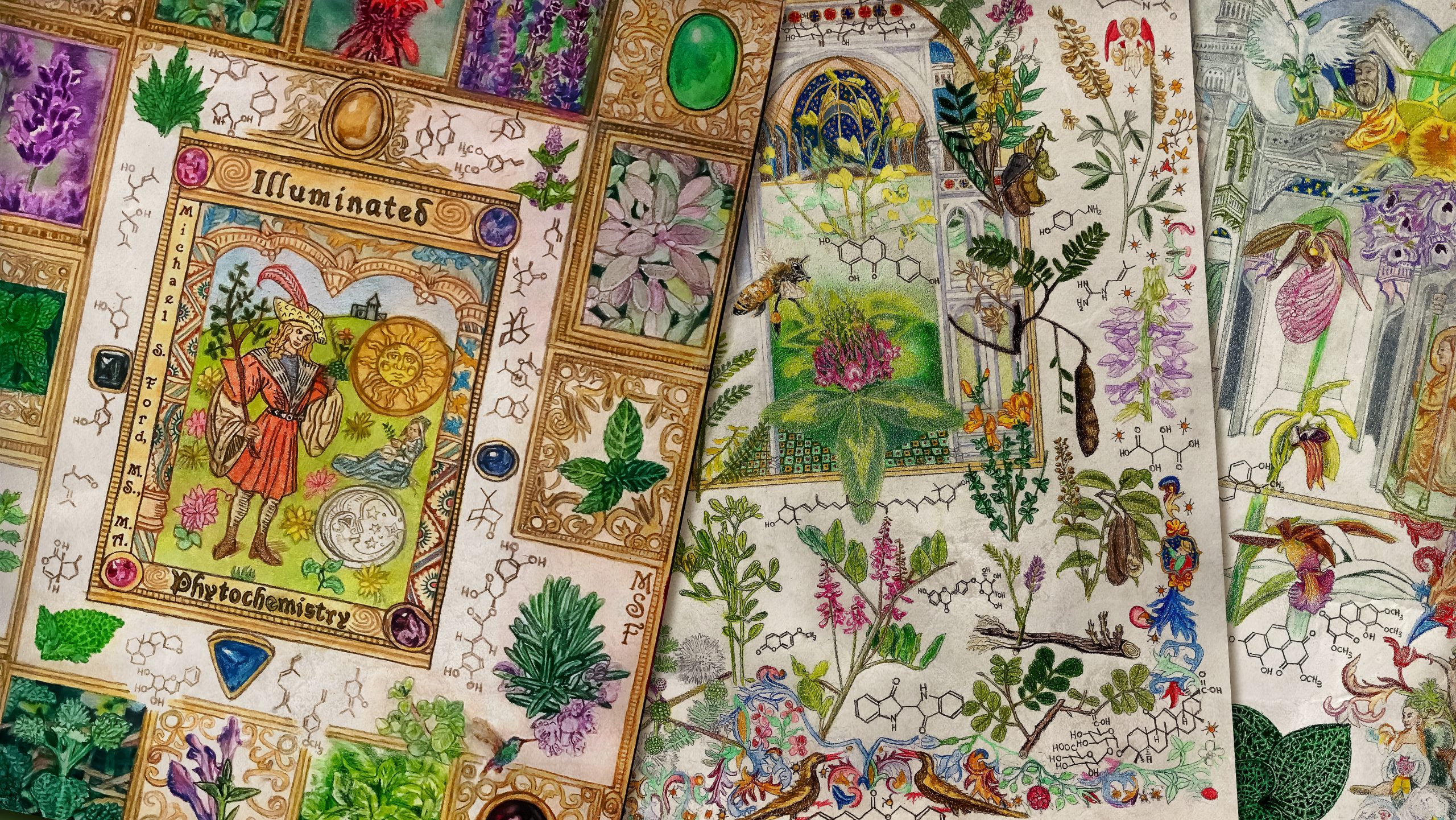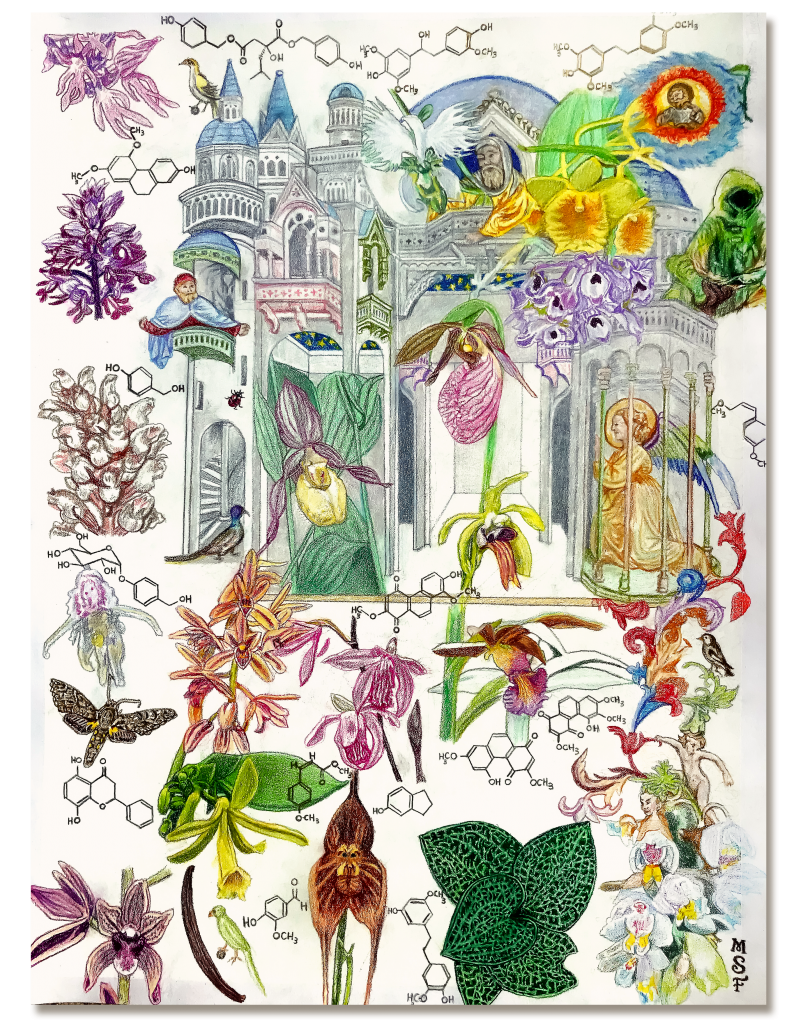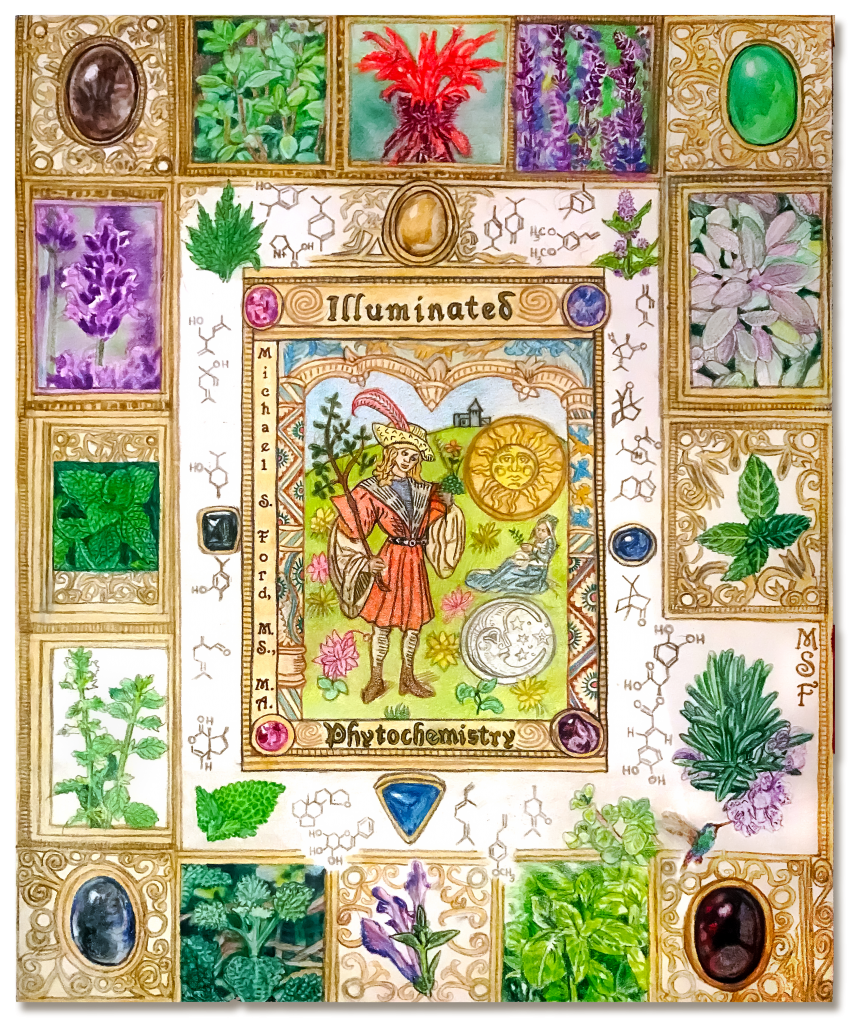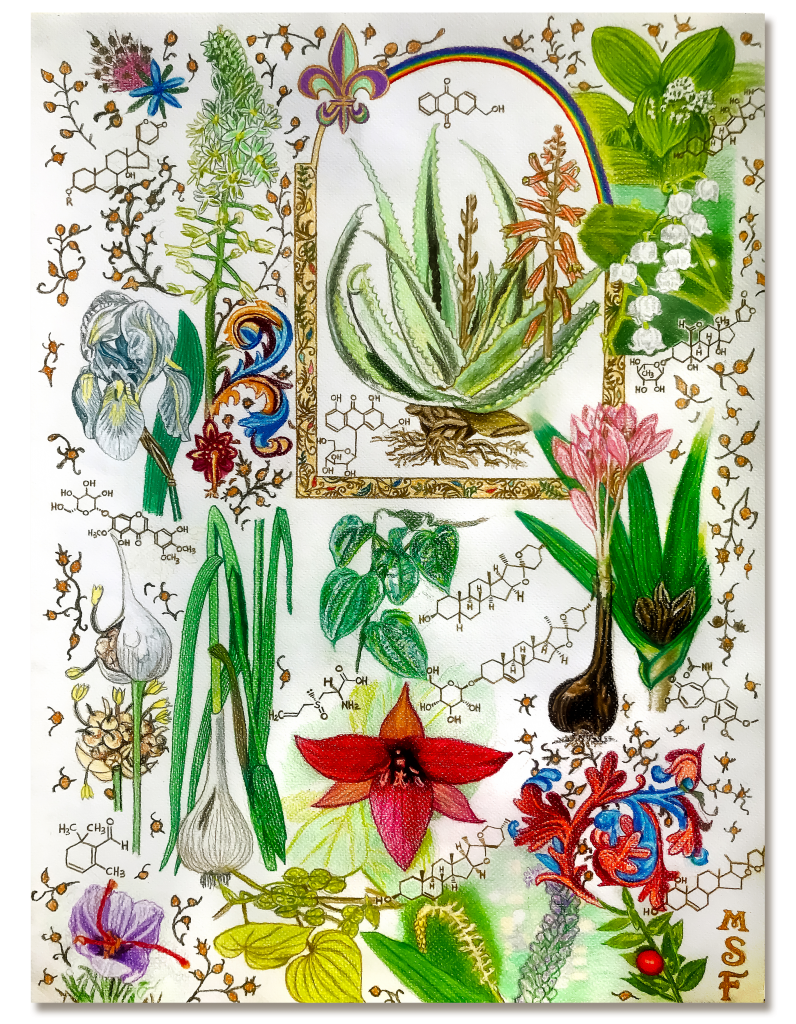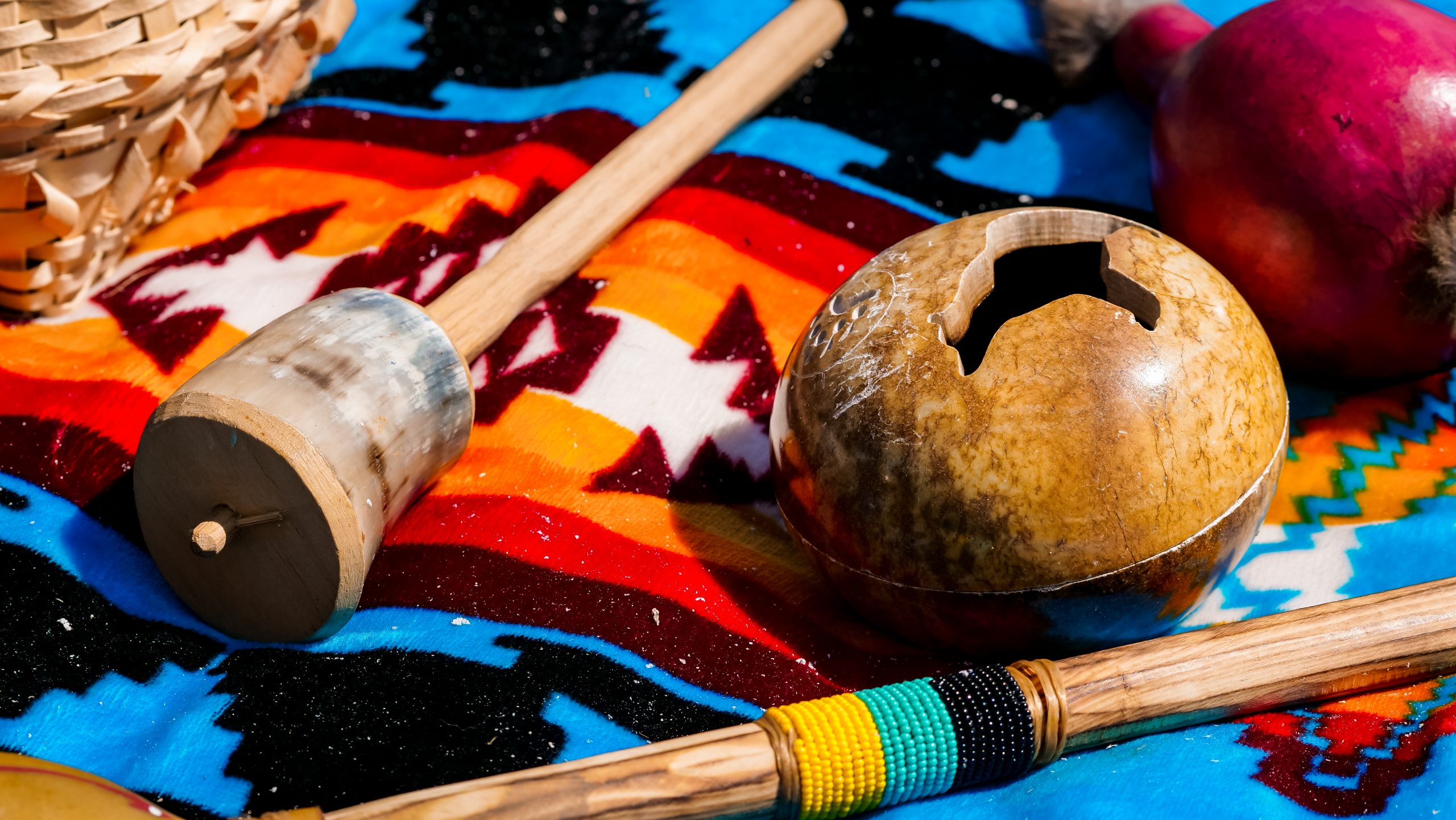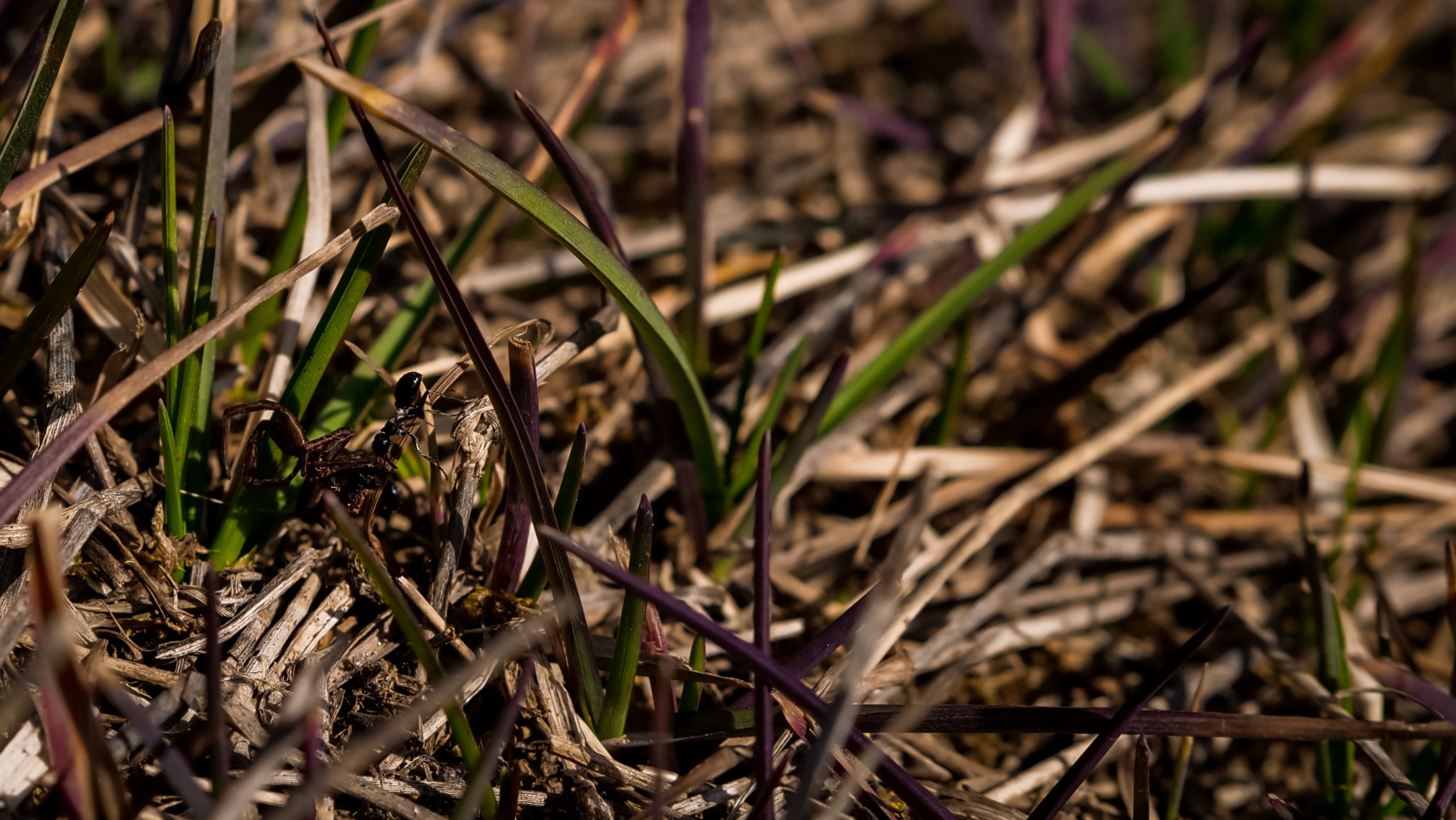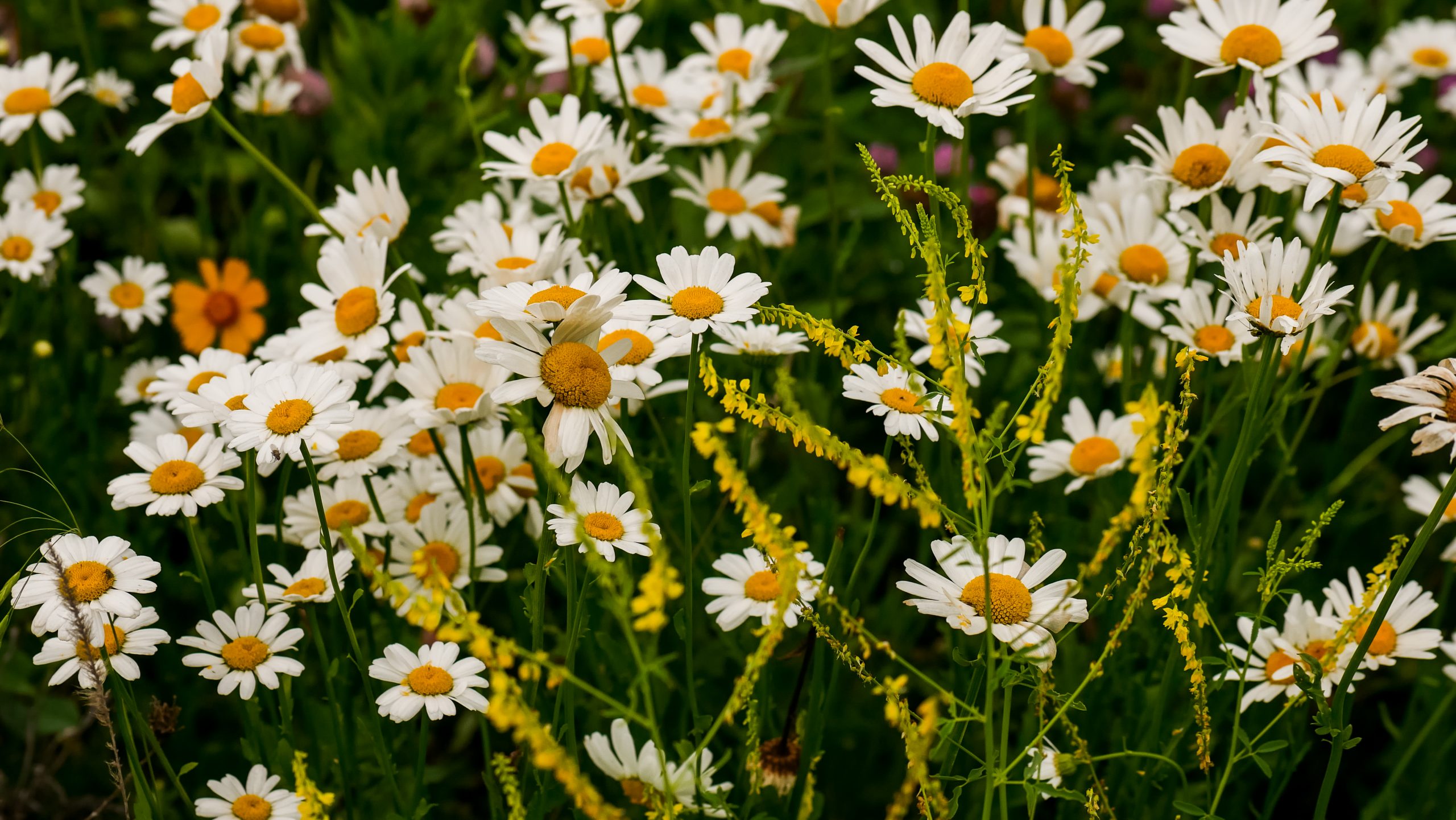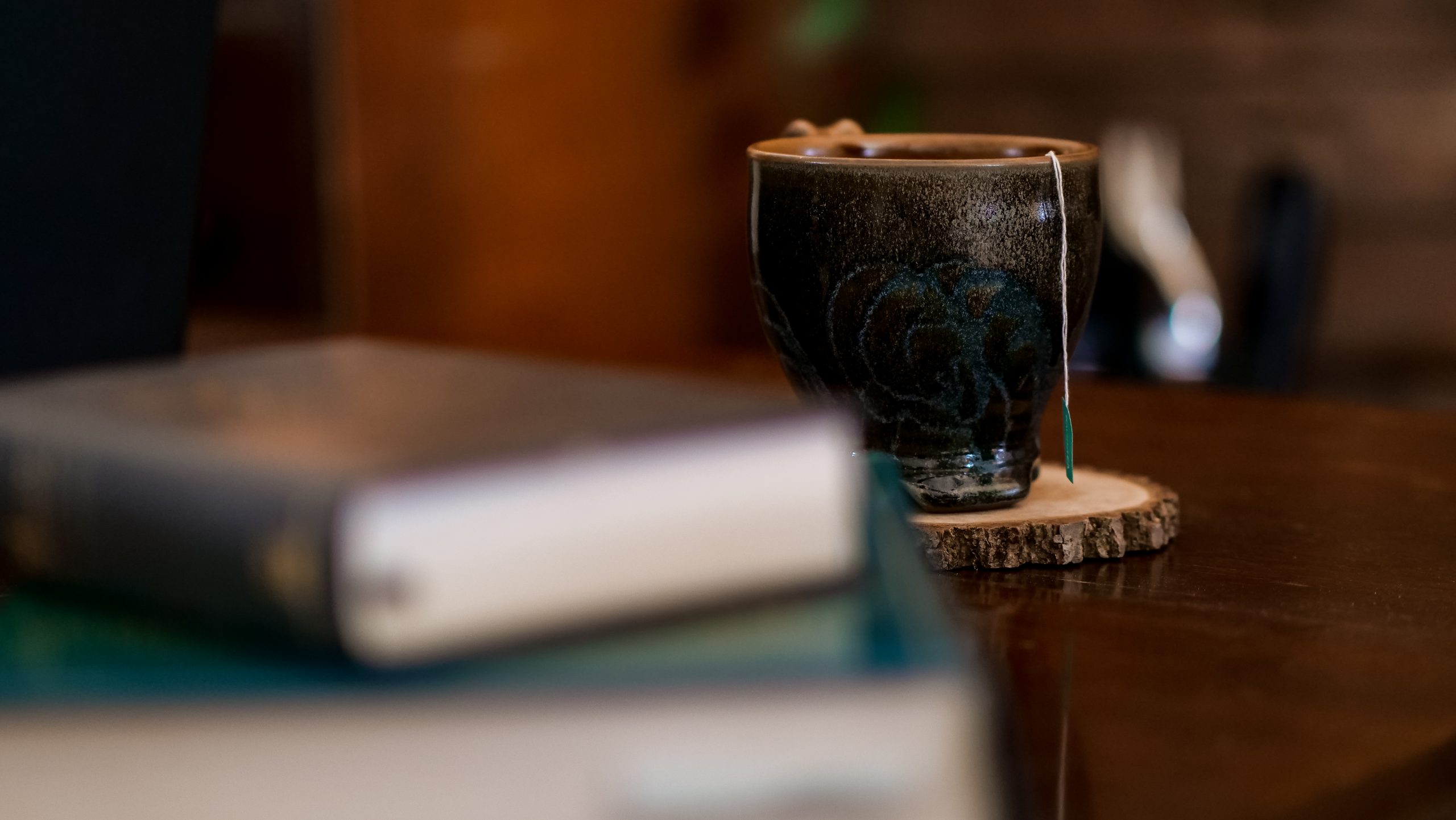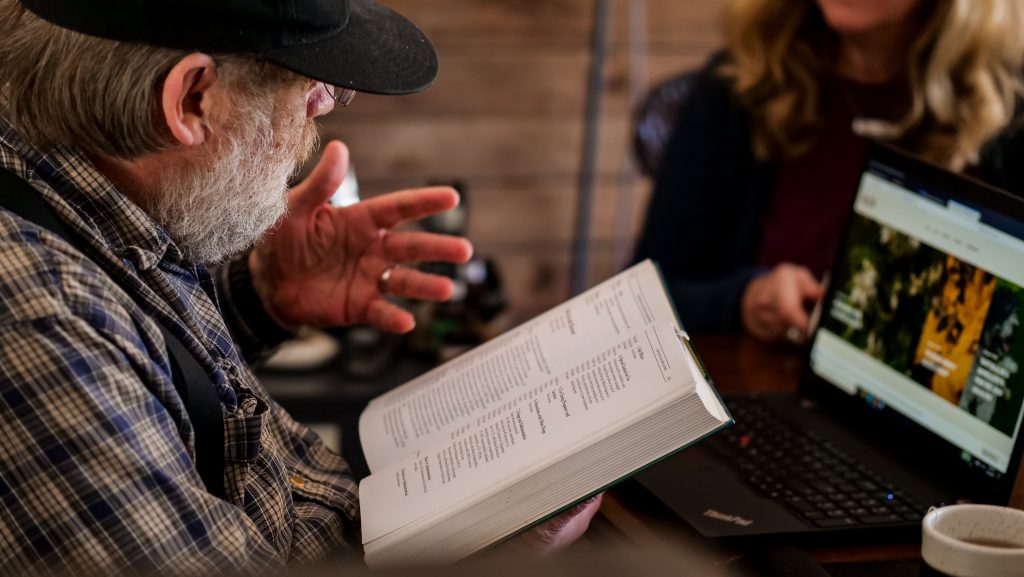Illuminated Phytochemistry: An Interview with Michael Steven Ford
Welcome to an interview with Michael Steven Ford! This interview was conducted by Victor Cirone with illustrations created by Michael.
Victor: Tell us a little bit about yourself!
Michael: I’ve been involved in the herbal community and have been working with herbal medicine for about 31 years now. It was 30 years ago that I took an apprentice program with Rosemary Gladstar in Vermont and then went on to start my own herb company – Apollo Herbs – manufacturing various herbal products and providing wholesale services to health food stores in the New England area. Then I went back to school and started studying the science of herbalism and earned degrees in botany and in pharmacognosy, which is a graduate program in pharmacy school that deals with natural product chemistry. I was there from 1998 – 2004 in the graduate program, and then I began teaching. I had been teaching herbalist apprentice programs throughout college, but in the end I ran about a dozen or more herbalist apprentice programs in the Rhode Island area, which is where I’m from originally. I later moved out to California and began taking all of the research that I did in graduate school and turning it into a book. In the book, I go through the plant families one by one, exploring various plants that have healing or nutritional or pharmaceutical value, explaining the trends in their chemistry. I’m also illustrating these plants and the molecular structures.
What can you tell us about the illustrations? They are quite striking and unique. There are not many herbalists that are creating work of this kind.
M: I forgot to mention, before I met Rosemary and studied herbalism I had been studying illustration at Rhode Island School of Design. I was going to school for illustration in the beginning, and then my whole course of study changed. Now I’ve come back and I’m tying it all together. I’m taking all of the botany and the pharmacognosy and the phytochemistry and trying to bring it to life in a way that honors the spiritual side of healing and of nature. I’ve chosen to do it in the style reminiscent of medieval illuminated manuscripts, of which there are many. These illuminated manuscripts tell stories, usually of a saint, or explore other religious motifs. I’ve been removing all of the characters and instead putting in all of the herbs, and then complementing the background with the molecules from their phytochemistry. At times, I’ve been putting in fairy spirits or different magical kind of images, but again in order to evoke the feeling of the spirit and essence of the plants. What I’m trying to do is to tie modern chemistry and science into that by implying that the spirits of the plants, or the essence of these plants, imparts its healing and nutrition and value to us through its chemistry. This is, of course, true, even if we are working in a holistic manner; it’s nice to know why certain things work, how they work, how to quantify the strength of something. The science does have a value, although I think that in modern society it has been greatly exploited.
There’s definitely a strong, almost alchemical resonance and quality to your illustrations. Can you say a little bit more about the traditions that you have been inspired by? Is there anything else that you can share about the tradition of the illuminated manuscript for those who are unfamiliar with such work?
M: I don’t know that my journey has been very traditional, it just kind of happened because of my various hobbies and interests and educational pursuits. I had learned the material and then when I was in the graduate program I had to put together a large study guide to learn all of the plants of the various families and their chemistry for my exams. I turned that research into a book later, which I never would have done otherwise. The idea of illustrating it relates to the fact that enough people are intimidated by the chemistry and the science so I wanted to make it seem more inviting and more fun, and show that there is an alchemical component to working with plants, nature, and medicine. The pharmacognosy that I have been studying is where modern-day pharmacy derived from, a lot if it anyways.
The traditions that used these plants often involved shamanism of some sort. I went to Peru in 2002 and studied with some Peruvian natives who were teaching shamanism to Americans. We did a couple of years of study. We needed to study with them before they let us go down and meet their teachers because they wanted to condition us to their culture – or uncondition us from our own culture, rather. When I was there, one of the old medicine men told me that he thought it was important that I honor my ancestors. I was into that, but I had never done it. When I came home I started researching my genealogy and trying to find out whom my ancestors were. Ultimately, that led me to writing a whole book about it, and I started illustrating the ancestors. I had inherited a lot of old photos, and so I began creating illuminations around my ancestors. I drew pictures that looked like medieval illuminations, but I put all the pictures of my ancestors in, creating something to honour each of the lineages that I had. Later, that gave me the idea to remove the images of the people – instead of it being my family, let’s make it a plant family. I started doing each one of the illustrations about one plant family, though in some cases I’ve done an order, because some plant families only have a couple of medicinal plants and I’ve been doing 15 plants in each one of these pieces. I’ve been working on them for a little more than a year now, and I’ve done 13 of them so far.
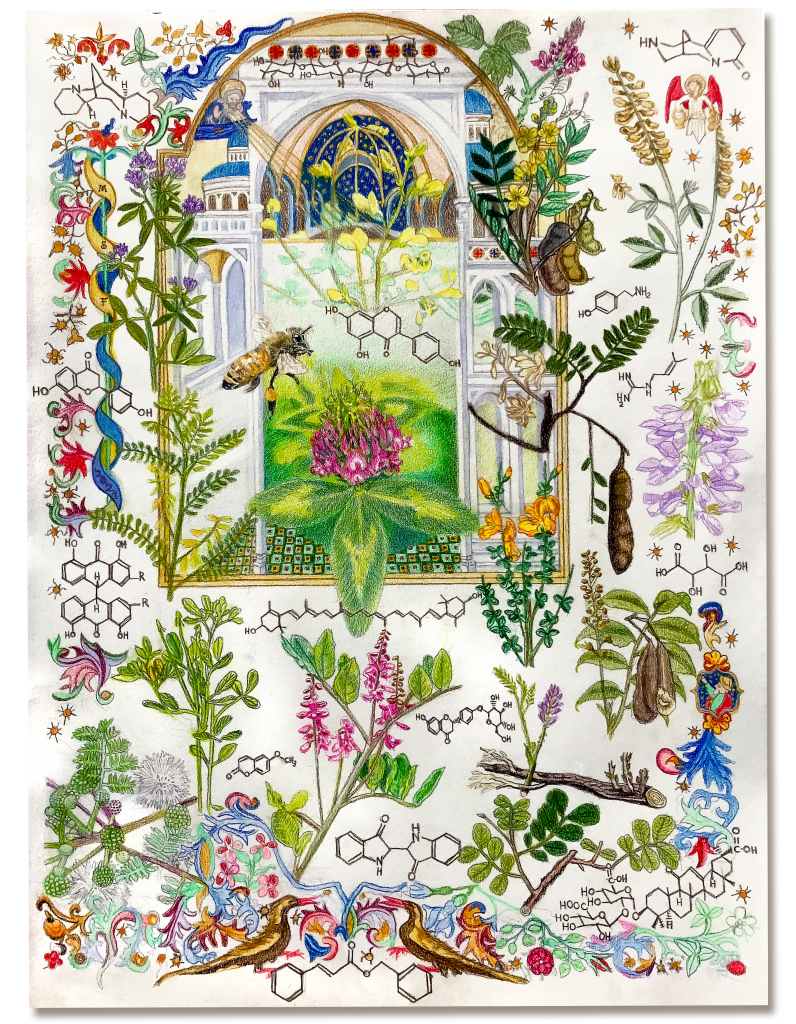
I’ve been doing this during the pandemic as a way to keep myself focused, it’s been a great refresher for me, too, because I’ve had to go back and look at all of the botany again and make sure that I’m drawing it anatomically correct, and looking at the chemical structures and making sure that I didn’t make any mistakes drawing them into the designs. I know that not everybody wants to learn this material, but if you are interested, learning visually is a good way to do it, especially when you start to associate chemical compounds with the plants that they are naturally found in. There’s not a lot of language associated with what I’m doing – it’s mostly symbolism and visual learning. The symbolism of chemistry and its molecules is universal in the world, even though there are some letters in there like ‘O’ for oxygen and ‘N’ for nitrogen. The rest of it is all imagery. Maybe some day there will be a need to preserve the visual component of which plants are in which families containing which compounds – I think that is kind of what I’m doing. Not that this information isn’t out there. I’m just putting it together in a new format because I have the ability to do it, I’ve spent a lot of time learning this knowledge, and now by putting it into a book, I can help other people to learn it, too.
You’ve mentioned that many people encounter difficulties when trying to study and deeply understand phytochemistry and its relevance to herbal practice. Perhaps you can say something about why you feel phytochemistry is important to the contemporary practitioner?
M: I think it’s a great tool; the chemistry is a very valuable tool for us to better understand and work with the plants. Especially when it comes to the solubility of what you are trying to extract from an herb. If you understand the basics of what type of compound, and how it would be classified, and what the basic actions are, and then looking at the basic polarity and solubility, you would know whether you could extract it with alcohol, oil, water, or glycerin – we’re not allowed to use other solvents, in pharmacognosy we had to use a lot of other things that I would rather not have used! It really helps to know if something requires Everclear to extract it because it has a lot of various fatty acid compounds or cholesterol or other very lipophilic compounds that extract well with organic solvents. And then there’s the sugars – if you’re making an immune formula that has a lot of polysaccharides that are complex sugars that stimulate the immune system, then hot water is sometimes sufficient depending on what plants you are using, and what you are trying to extract. Oftentimes there is a mixture within the plant, and that’s the reason that 50% water and 50% alcohol seems to work well – not that it’s a magic ratio or anything, but that 1:1 ratio does work for a lot of herbal extracts, because its right in the middle. Likewise, I am also very interested in essential oils and hydrosols. I got involved with cosmetic formulation and manufacturing for a while. It’s the same thing, just using it for a different purpose – in terms of getting plant extracts and manufacturing products with them – which led me to teaching more about it.
What can you tell us about the book? Does it have a title yet?
M: I’m planning on calling it ‘Illuminated Phytochemistry.’ I’ve created a cover for the book – the cover has the mint family on it and I put some of the menthanes and various terpenes that are in that family on here. That was one of the very first ones that I drew. Like I said, I’m on the 12th or 13th illustration. I’m working on the Mallow family right now. I’ve done the Orchid family, the Apiaceae, Rosaceae, Fabaceae, Asteraceae and Solanaceae [Nightshade] family, to name a few, but I mean there’s hundreds of families, so its unrealistic to think that I can illustrate them all in a reasonable amount of time, which is why I’m just choosing the ones that are of healing, medicinal, nutritional, and/or cosmetic interest. I think it is valuable to organize this information in this way so that you can quickly look at a plant family and see which plants are closely related, and how they are related chemically, so if you didn’t have one plant available, you might be able to substitute it with another plant, or you could see which plants you could extract together because they might have similar solubility or action. This is far from folk herbalism, what I’m doing, since I’ve organized it using the scientific tradition. But I’m really hoping to blend the two. With the art, to use the right side of the brain to teach more left-brain material. I can be very left-brained, but I can be very right-brained, too. It just depends on what I’m focused on at the moment. I think that we can all do that; we just have to believe in ourselves to do it.
We are all conditioned in certain ways and have tendencies towards certain kinds of activities, but the potential for both right – and left – brained activity is always already there, it just depends on the circumstances we find ourselves in and how our minds get awakened.
M: Finding the right teacher can be really important, because sometimes somebody presents this sort of material in a way that is really inspiring to others, as well as in a clear way. You also have to be willing to do the work. When you are getting involved on this level, there is a certain amount of discipline that just comes with the territory, as in running a lab or approaching taxonomy or phytochemistry – these are disciplines that you have to study before you’re allowed to do certain work, there are prerequisites involved. I’ve taken a lot of this material out into the public to teach people who don’t have those prerequisites. In some cases it can be intimidating, but other times it really makes people say ‘wow, that’s cool’ and ‘I wish I knew more’ or ‘I want to learn more’, and those are the people I’ve worked with over the years.
What about the text that is going to accompany the illustrations?
M: The coloured illuminations that I’m doing, I don’t have the publisher yet, so I can’t say if they will all be in the center of the book or will appear as chapter heads for each section. I will probably go from simple to more advanced, starting with the monocots and going to the dicots and ending with the aster family, which is the way that most of the botanical texts go. I might put the illuminated image at the front of the chapter for each corresponding plant family, and then have the text, and then have smaller illustrations of e.g. the shape of a leaf or other types of botanical illustrations that will help people learn the plants. It’s not just about phytochemistry – its bridging botany and phytochemistry together for the purpose of healing arts.
We are trying to compile a contemporary history of herbal medicine at Everything Herbal, and we are asking various people to share their experiences with the evolution of the herbal medicine world as they’ve experienced it.
M: It’s changed a lot since I got involved. I’ve been involved for the last 30 years – big business got involved over that time period. When I first started my herbal company in 1991 there weren’t the regulations in place that there are today. The ‘good manufacturing practices’ are more stringent now than what companies were doing back at that time. Much of it has to do with sterility, cleanliness, proper identification, record keeping, making sure you have good procedures for extracting and preparing your products. They want the products to be good quality, and there are good reasons for those things to be in place. We are now dealing with a corporate, multi-billion dollar global industry. I’m concerned about the plant populations and I’m hoping that they aren’t going to be exploited too much, where we start losing various species of plants due to overharvesting or environmental damage. I saw that – I was one of the earlier members of the United Plant Savers because I was studying with Rosemary Gladstar when they formed that group; they were meeting up at Sage Mountain when I was still a student. There are a lot more organizations today dedicated to conservation, more educational opportunities, and the preservation of the knowledge – including support for indigenous knowledge and indigenous cultures. There is more respect for diversity in general. Lately I’ve seen politics becoming involved too, and people getting upset. I’ve just tried to stay out of that to the best of my ability although I really hope that we can all learn to just get along and respect each other. That’s what the whole human race needs. That’s such an understatement!
Herbal medicine has also been so viciously attacked by the allopathic establishment…
M: I remember when I was pharmacy school everyone was very skeptical of me there at first. The allopathic environment was not pro-holistic. I gave a graduate seminar on the use of hallucinogenic compounds from plants for psychological and psychiatric research and they nearly laughed me out of the room. Now it’s a hot research topic. But 20 years ago, they just weren’t ready for it. All that research started in the 60s, it’s not anything new, but they were just closed-minded to it. This has to do with international patenting laws, what is deemed a drug and what is not, and all the regulations around all of that. I like to point out that the word ‘drug’ comes from the old Dutch word drogge which means ‘dried plant’.
What are some of the directions that you’d like to see herbal medicine move into?
M: I think it has moved a lot, I don’t know that I’m the right person to say what it should be for other people, but I would like to see it more accepted by science as something valid. I’d like to see the scientists have a more diverse approach, where they can incorporate nutrition, herbs, as well as allopathic medicine and various types of physical treatments into their practices. I think we are moving in that direction. I don’t think the insurance companies are ready to jump behind it, and go along with it as part of standard practice, though. I guess it depends on where you are and who you are working with. I’m surprised to see, still, the amount of resistance that is out there from some people. But it’s not my place to judge. They have a lot better marketing programs – the pharmaceutical companies.
Maybe you’d like to talk about your interest in psychoactive plants. It is a topic that can be quite polarizing – you have some herbalists that are strongly opposed to the use of psychoactive and entheogenic plants and other herbalists that totally embrace and are very excited by the potentials behind such usage.
M: I can clearly see that there’s a polarity there. I don’t see any reason why these plants can’t be used, at least experimentally as medicines, when we have allopathic medicines that have all sorts of bad side-effects and that people are supposed to stay on for long periods of time. Some of the shamanic techniques that are being tapped into are helping to release trauma through using these types of compounds. There was often some kind of ceremony or ritual, someone observing a person to ensure their safety, and done in a context of working under somebody who was experienced and knowledgeable. We’re not talking about someone who wings it, because then they are risking the possibility of things going wrong. I don’t want to say one way or the other – I don’t have a problem with people using these plants traditionally, but I don’t want to sound like an advocate either.
It depends on the individual and their need for therapy. I understand that it goes beyond that – there’s a whole culture of people who have used these things for other purposes, going back to the hippies and the 60’s and the Grateful Dead & psychedelic rock… I’m not even old enough to have been around for that, though I appreciate the music. People are going to use various substances whether they are allowed to or not. It is better to be safe about it, and perhaps if there was more education available… I don’t want to sound too idealistic in my thinking. I think it’s a shame that there’s so much drug abuse in our culture. We should be looking at why people are engaging in this kind of behaviour. Instead of blaming the drugs, let’s look at the definite social and cultural issues that are lying at the root of this behaviour. Let’s learn to use the compounds and plants more intelligently. I hope that someday we have a system that is more conducive to that, more accepting of that.
It’s interesting to observe the contemporary psychologists and psychiatrists who are using psychoactive plants and compounds in a therapeutic context. Some of them are doing interesting work, but it’s always within the confines of the psychiatric model. Definite limitations are set: we’ll allow you to experiment, but only if you are doing so within our officially sanctioned framework. Forget about traditional use, they’re not interested in traditional use. There is the traditional medical pharmaceutical model, which is open to very minor modifications, and that’s what you have to exist within if you are to be granted any kind of legitimacy.
M: The medical field tends to do that, to compartmentalize in that way. I’m not saying it’s the only way to approach it, but if you were going to investigate, there are maybe other ways, such as working with indigenous peoples and finding healers who are educated, and who can assist people with the use of these plants. There’s always a potential for someone to have a bad trip or to harvest the wrong plant or take too much of something and have a bad reaction, and you don’t want that to happen. This work certainly has the tendency to bring up people’s traumas, and if they have traumas and haven’t healed them, then there’s a chance that they might be triggered.
What do you feel herbal medicine has to do with understanding ecology and sustainability? Can you share some thoughts about the relation of herbal medicine to ecology generally?
M: I think that herbalism is one big part of our survival skills as a species and it’s probably the oldest, or one of the oldest, of such skills. And because of that it evolved a lot differently than lot of other systems that are operating now. A lot of the way things are operating now, in broader context, is based on corruption, a corruption of science, with the aim of trying to create global monopolies, which they have done. Humanity needs to live in balance with nature, it would certainly behoove us to, and herbal medicine is a huge part of that. It is very important that we preserve these traditions, that we continue learning and researching, and that we teach our children and grandchildren, and the future generations. That is a constant, that has always been the case, but even more so now because we have so many competitive fields that are against what it is that we are doing. It is all the more important for us to preserve what we have, updating it, and passing it forward. I hope that the future generations can use all of this as a key to living in harmony with nature and figuring out the various health problems of humans and animals. There is so much potential, it’s just a matter of getting enough of our collective attention focused on that potential. The people around the world are pretty united – a lot of people use plants, all over the world. That kind of a movement can be supported. It’s already there, but it’s an underground movement. I just don’t want to see it become further exploited into some kind of unappreciated resource that does even more harm to the planet.
Then it becomes a vicious cycle, the deeper the patterns and cycles of dissociation humans end up falling into the greater and more difficult are the perils we have to face in the long term. It’s one big self-defeating cycle. It can be said that the disease process often develops as a way of pointing out what the error is in our way of being in the world, disease as a means of making you as an individual aware of what you need to change or shift in your life. When you suppress that information either in an individual body or in the context of a larger ecological matrix, then you are simply creating an even more chronic, long-standing condition that is even more difficult to cure.
M: I agree. I would like to see the system less profit-oriented, too. I’m in no place to make that happen. It’s a shame that things have to be all about money when we are working with curing diseases.
Anything else you’d like to discuss or share?
M: I am going to be producing a website, I’m going to be selling botanical prints and some of the art I’ve been creating outside of publishing it outside of the book. There have been a lot of requests for posters, t-shirts. I have been posting the images on my Facebook page as I’ve been creating them, so I will likewise be posting more information regarding that.
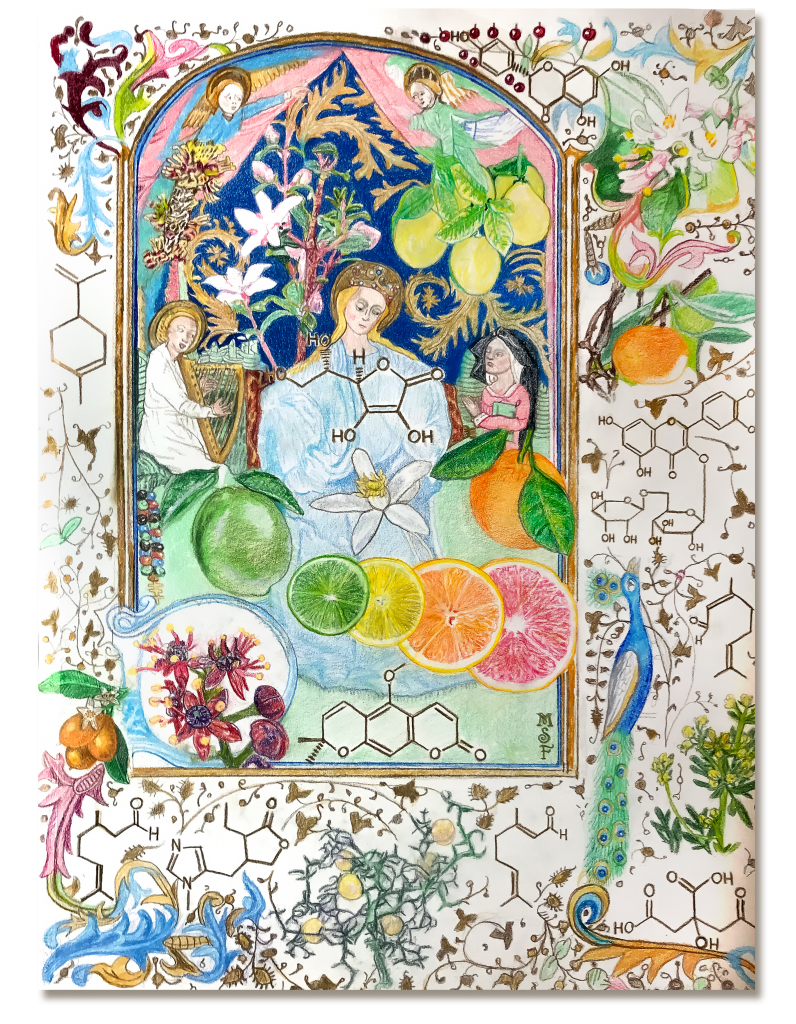
If you would like to check out more of Michael’s work and follow the journey of his book, you can find him on Pintrest.
Creative Wellness at Eagles in the East Studio
Welcome to my Studio
Or, more accurately, my life on the eastern shores of the Georgina Island First Nation.
Here, from my home and small studio, I can look across the waters of Lake Simcoe and see Beaverton, Ontario. Although one can witness a spectacular sunset on the west side of the island, I so enjoy the sunrises – when I’m up in time!
I am Anishinaabe Kwe, an artist, a plant medicine practitioner and a spiritual seeker. I love all things that support creativity and well-being, and believe my purpose in life is to be inspired or be “in spirit” and to inspire others. One needs to be inspired to create! To create a painting, to create a medicinal tea, or to create a life full of joy… In the end creativity is a way to well-being.

Art and Medicine
I create eastern woodland style First Nation art pieces that are inspired by my island environment. Georgina Island has unique flora and fauna and a variety of birds and animals that fill my spirit with such joy. I paint loons, herons, eagles, hummingbirds and anything that calls to me to create. My work also captures floral patterns that are based on traditional Ojibwe beadwork designs. My first creative love was Ojibwe beadwork that my mother taught me when I was 12 years old.
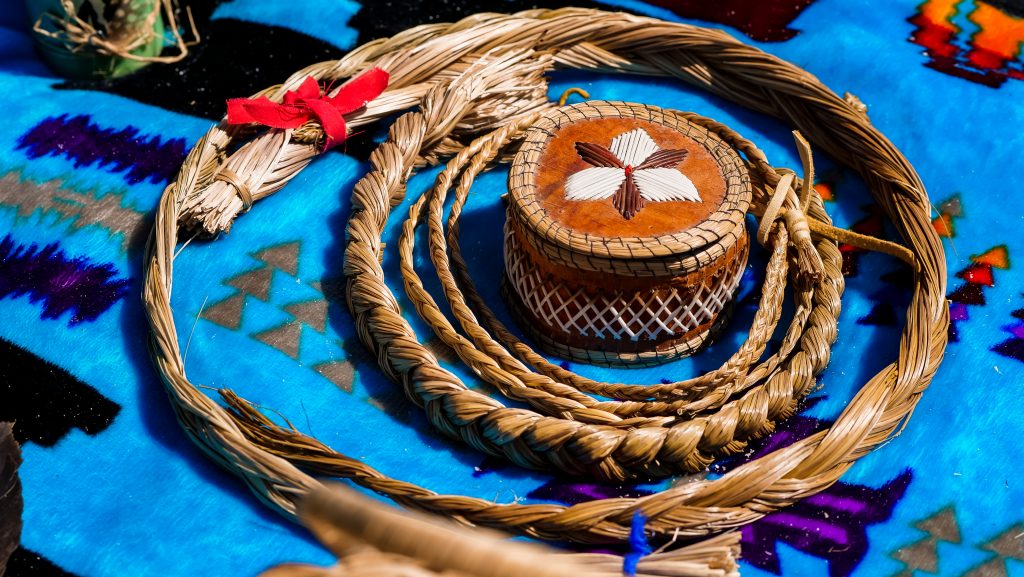
My other passion is for the plant medicines, particularly the traditional medicines that have blessed our territory for hundreds of years. It is an honour when our elders pass on the traditional teachings of these medicines for both their spiritual and medicinal uses, as those teachings are meant to live on. The elders tell us that the plant medicines may speak to us, but only if we choose to listen will they will heal our bodies, minds and spirits. In Anishinaabe culture we have four sacred medicines; tobacco, sweetgrass, cedar and sage and we use these medicines in our ceremonies.
I have a vision of the plant medicines in my art. They are asking that I include them and capture their essence in another medium, other than tinctures, salves and teas. I can’t wait to see what more comes!
Healing The Rift
The Healing Professions, Human Freedom and The Social Good: Book Burning and the Psychic Depravity of Authoritarianism
From their heights the Gods reach down into the ocean of humanity and feel the warmth of love. We know that the Gods lack something when man does not live in love. The more human love there is on earth the more food for the Gods there is in heaven; the less love there is, the more the Gods hunger. - (Rudolf Steiner – GA 105 – Universe, Earth and Man: IX – Stuttgart, 13th August 1908)
Those who are genuinely engaged in the healing professions have an absolute and unshakeable responsibility to perpetuate and promote health, harmony, love, truth, and justice in the world. Medicine is to be practiced in the service of The Good. The primary task of a healing professional is to work for the benefit of humankind, to promote the flourishing of life, to alleviate suffering to whatever extent they possibly can, and to allow for individuals and communities to reach their highest potentials in body, mind, soul, and spirit. It is incumbent upon healers to cultivate the courage to heal in themselves and in their patients, for it is no small responsibility to help the sick and requires nothing less than unwavering and unfaltering devotion.
It is untoward for healers to perpetuate lies, illusions, and false-truths. Lies and illusions affect human beings in very deep ways, and are in fact the underlying cause of a great many illnesses and states of dis-ease. Our soul life becomes greatly compromised when we are fed unlawful images or repeatedly exposed to deceptive and manipulative words. Such impressions that are marked with the insignia of their own falsity and untruth create unconscious disharmonic resonance patterns that affect the entire organism in very adverse ways. Unlawful images direct the soul away from what is good, beautiful and true in nature, and this inevitably leads to states of malaise, characterized by mental instability and tendencies to violence. The healing of the soul and the healing of nature both require that we pay attention to the flow of inner images, and learn to be guided by true Imagination, which is integral to our capacity for genuine love and devotion.
True Imagination is also what allows us to feel into the inner experience of another, to demonstrate empathy. Rudolf Steiner taught that empathy is a prerequisite for true healing. Healing must start with empathy, for it is empathy that allows one to generate an understanding of and feeling for another person’s underlying circumstances and condition. It is empathy that teaches and allows us to metabolize another’s experience, and to recognize what it is that needs to be healed in them.
The Controversy
Recently, a massive controversy has erupted in the international online herbal medicine community. An article written by Stephen Harrod Buhner entitled ‘The Day The Woke Mob Came for the Herbalist’ is what sparked this controversy. This article is available here for anyone who cares to read it.
Many people took issue with Buhner’s article for a variety of different reasons, and many adamantly supported and promoted his views. It is not my prerogative here to explore what Buhner is or is not saying in this piece. Both sides of the divide have ended up accusing each other of misunderstandings, exaggerated and false opinions, distortions of reality, misconstruals of history, inflated egos, and all the rest of it. A condition of disharmony was created that is now reflecting negatively on the herbal community as a whole. We are dealing with a pathology that has infected the psychic life of our profession, and which has adversely affected the capacity of many to exhibit truth, empathy and understanding.
Irrespective of what Buhner said in his article, he had the absolute right to say it. If you disagree with his words, or the words of any other author, then there are a number of legitimate ways of voicing your opinion, and of raising critical opposition. It is through such civil debate and dialogue that we are able to strive towards the ideal of an enlightened society, as the philosopher Immanuel Kant understood it:
“Enlightenment is the human being’s emergence from his self-incurred immaturity. Immaturity is the inability to use one’s own understanding without the guidance of another” (Immanuel Kant, ‘What is Enlightenment?’).
Rigorous public dialogue and debate, with the aim of arriving at truth, is what allows for enlightened self-understanding to emerge in a social world. Censorship, and the negation of free speech, is inherently opposed to this ideal of communal truth making. When one speaks or acts in the public sphere they are accountable to all, for they are acting as a member of “the society of the citizens of the world” (ibid). We all must take full account of our words, for our capacity to speak freely carries with it immense responsibility.
The Freedom of Speech
One of the greatest negations of free speech and the perpetuation of authoritarian censorship is to be found in the act of burning books. This is how one herbalist of Toronto decided to respond to Stephen Buhner’s article. Book burnings have been carried out by some of the most despicable parties in world history, including the Nazis and the Hitler Youth, Mao Zedong (as part of his Cultural Revolution), and the U.S. Food and Drug Administration (who in 1956 burnt the publications of Dr. Wilhelm Reich). Many other examples can be given to illustrate just how pernicious the act of book burning is, and how it serves as an assault against the pursuit of freedom, truth and justice. The motivations and values behind book burning are diametrically opposed to the motivations and values that a true healer should always and in all circumstances maintain and serve to uphold. Read more
Thoughts About Ants
We Are All Connected in This Deep Web of Life…
I thought it was important to appreciate the hard work of other ‘beings’ who give so much to this great tapestry called Earth, a work of art that Mother Nature weaves continuously.
So today we are sending a short shout out to Ants! They have been a welcomed sight in our rewilding fields and sanctuary over the past thirty years.
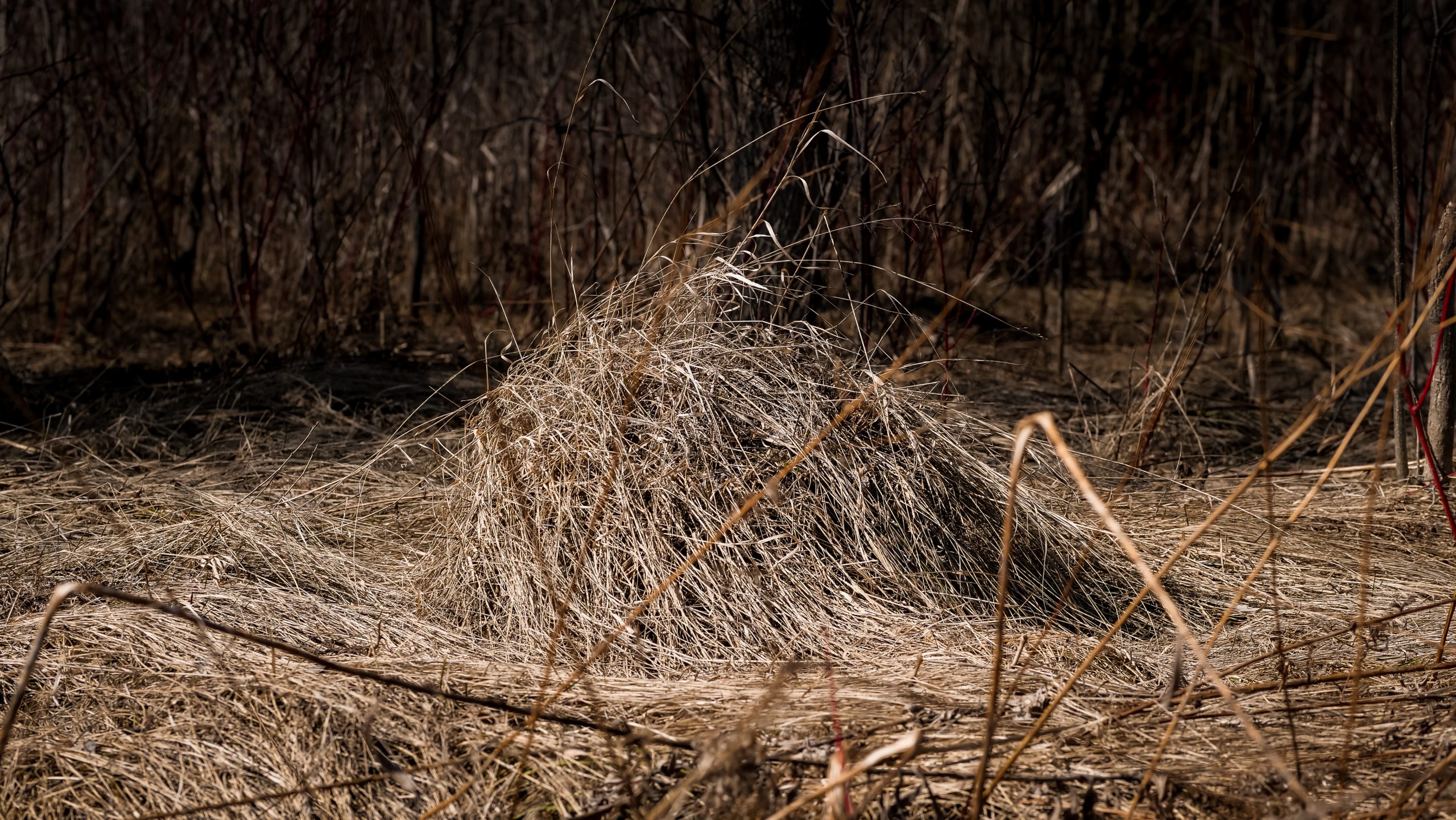
Building amazing hills over a foot high. Within these hills and far below is a labyrinth of tunnels that aerate the soil and allow moisture to get to the roots of surrounding vegetation.
The ants – these amazing decomposers — bring other insects and leaves deep into their nest, which will decay and fertilize the neighboring plants. Ants are one of our beloved pollinators and seed distributors, working their magic throughout our gardens and fields. Ants are also an important source of food for many other essential insects, birds, and mammals.
Just the kind of insect these fields longed for – connected to the pulse of creating life and sustaining life.
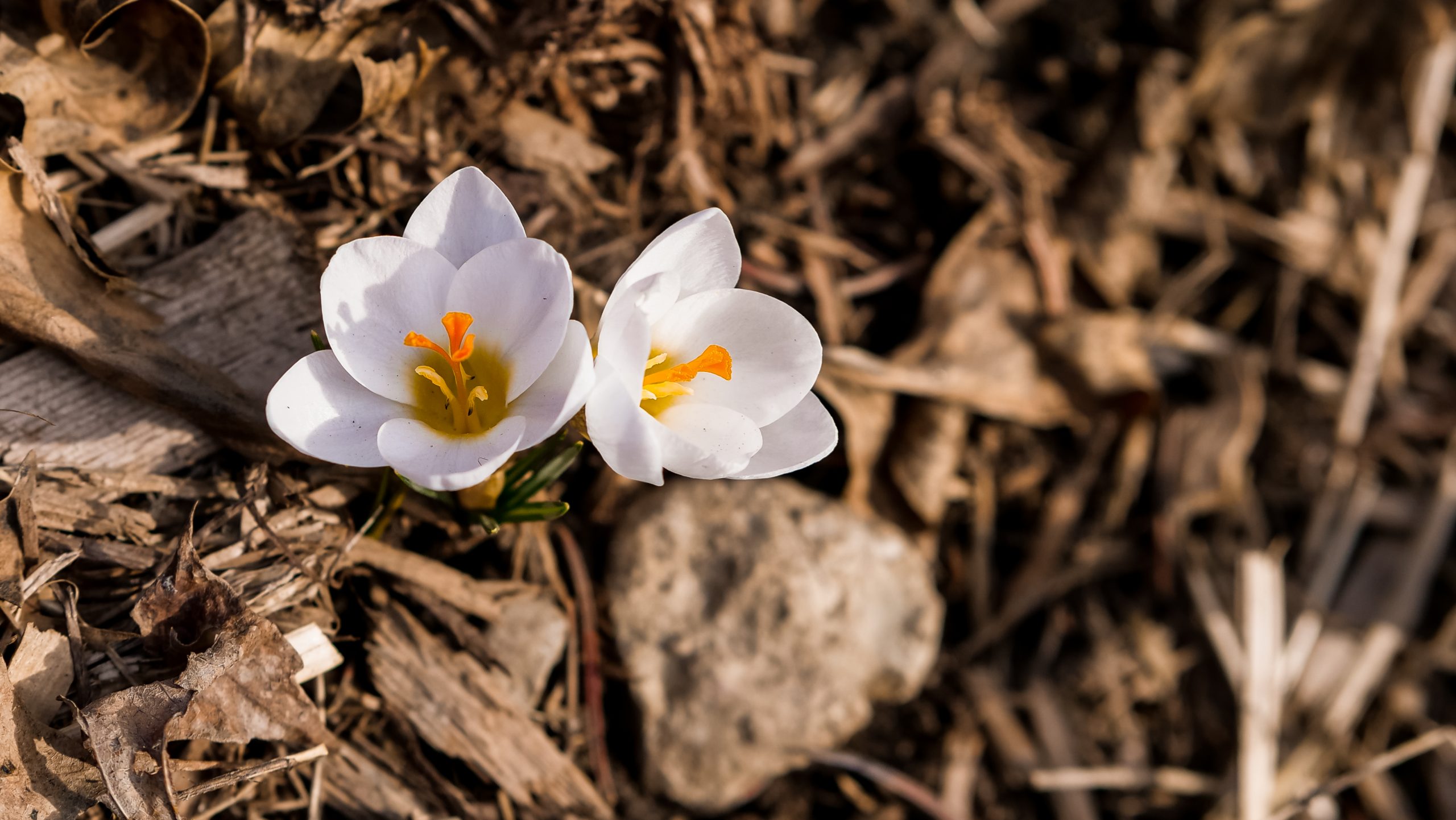
Herbal Histories: Chalid Ottway, Planetary Herbalist
Consumers in the United States spent an estimated $9.602 billion on herbal dietary supplements in 2019, an 8.6% increase in total US sales from the previous year, according to the American Botanical Council’s (ABCs) 2019 Herb Market Report.
And this is expected to increase for 2020 and 2021. Yet 95% of these sales would not exist without the work and devotion to their craft of the herbalists of the recent past. Herbal medicine today truly stands on the shoulders of all those who came before.
In this blog we will look more into some of these herbalists, Starting today with one of my favourites Mr Chalid Ottway, a true descendant and student of Aviccena – one of the greatest herbalists who ever lived. (To learn more about Aviccena, see Mr Ottway’s short biography of him at the end of this blog.)
The Beginning
Chalid Ottway was the descendant of a notable Arabian family, dating back many generations, all of whom were distinguished for their knowledge of medicine and service to humanity. Looking to expand his horizons and to bring his skills and gifts to a new audience, he arrived in Toronto, Canada in the 1920’s.
Canadian medicine in those times was very different from today of course. As was the culture. As an “Arab” Mr Ottway had to deal with rejection and contempt as he tried to present his methods, remedies and formulas to a suspicious Canadian public. The medical establishment of the time ignored him, the people had no time for him. He had no social status and had arrived in Canada with virtually nothing. What was he to do?
Mr Ottway, a deeply spiritual man and devoted Muslim in the very best sense, decided to fall back to the original methods of his historical mentors. He set up a stool and box, that he carried around on the corner of Canada’s busiest streets – Yonge and Bloor in Toronto. A hand written sign offered to cure corns of the feet free of charge and he sat and waited for his first “customer”.
Corns can be painful, and back then many of the abundant patent remedies were useless. I am sure that many passers-by were willing to try anything. And of course, you guessed it, his remedy worked spectacularly!
Word soon spread of the “little Arab” on the corner, and people began asking him for more remedies. Crowds gathered around, forcing him to seek out proper premises, which he found on Danforth Avenue in 1930, just east of Yonge and Bloor.
From then on Mr Ottway’s business thrived. He produced multiple products at his store and sold them all over Toronto. As his fame spread he set up a mail order section at his store and shipped his products all over Canada. Some of his more famous products included Nerviton tablets (obviously for the nerves) and his Herbiton tonic and pick-me-up. Check out the pics of his product labels!

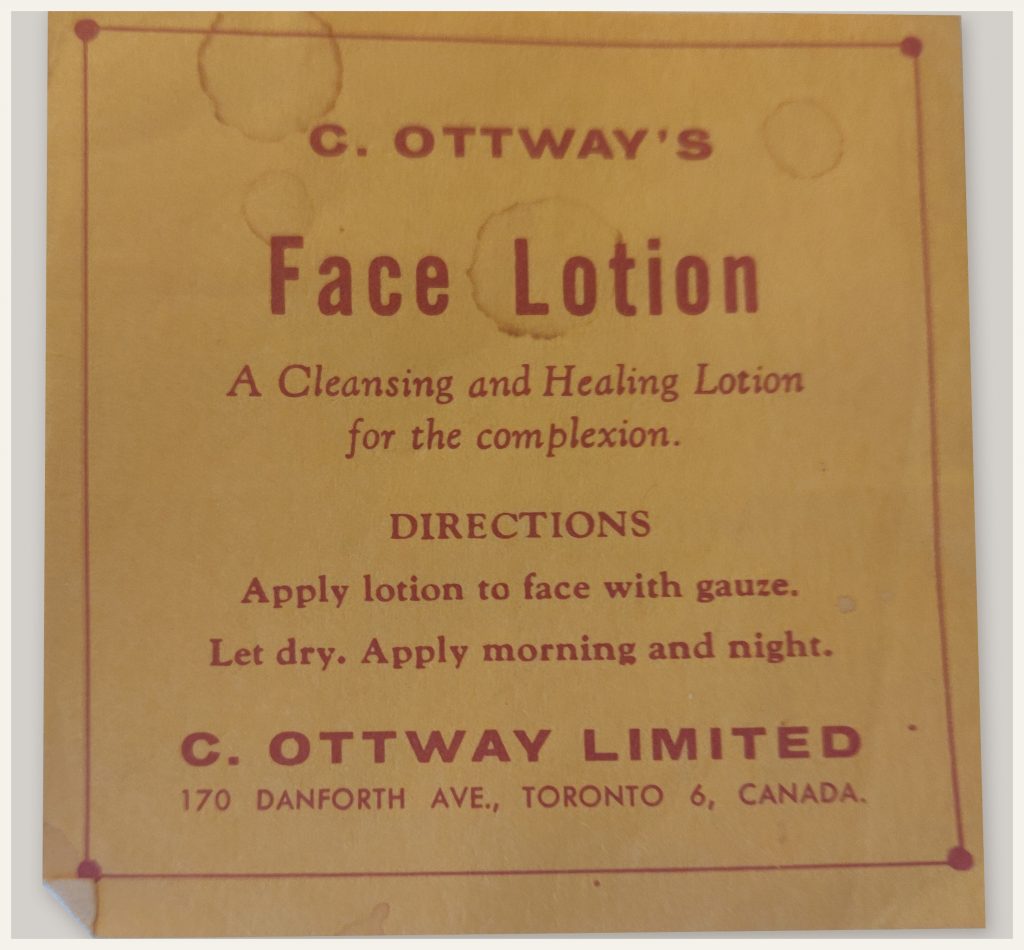
(Photos of these labels taken by Nick Faunus)
Mr Ottway became a popular and highly regarded Toronto character and was featured in the newspapers and on the radio. On one occasion he was taken to court for “illegally practicing medicine” but the public outcry against this was so great that the court summarily dismissed the charge, and he was never charged with anything again. Mr Ottway was also generous in his support of the poor and disadvantaged, giving free remedies and advice wherever it was needed.
Once, when he heard of a small boy suffering badly from boils, he offered to take care of him – and the boils cleared up in five days! After seeing the suffering that the poor boy went through, he vowed never to charge for the formula and gave it away freely to whomever needed it. The treatment consisted of only five capsules!
Along with Thuna’s (that’s another blog!) Ottways was the primary source for herbs in Toronto, up until the early eighties. Mr Ottway died peacefully in his sleep at 70 years but the products were still being made by his assistant Mathew Cameron, until he retired in the late eighties. The business has changed hands several times since then and still exists in a different location, but is still on Danforth Avenue. However, the unique products are gone and are no longer made there, although the store carries a wide selection of modern high quality products.
A personal note …
Mr Ottways story appeals to me for many personal reasons. I too arrived in Canada with nothing but my bag of herbs, and had to go out on the streets to sell them, in the early eighties, to live and eat. It was a struggle at first though always fun and fulfilling, but like Mr Ottway I never doubted the power of the herbs and my faith in them was rewarded many fold.
Most importantly I met my wife there in 1984 (she was working in the dispensary in the back). She heard me talking to the owner about some herbal products I was hoping to sell and caught me on the way out. She barely spoke but handed me a piece of paper, which I looked at when I arrived back at my rented room. It was her phone number, and we were married within a year! This year marks our 36th anniversary.
Isn’t it amazing what herbs can do for you!
We are always interested in learning more about Mr Ottway (and other past herbalists). If you have a story about him please get in touch with us here at hello@everythingherbal.ca!
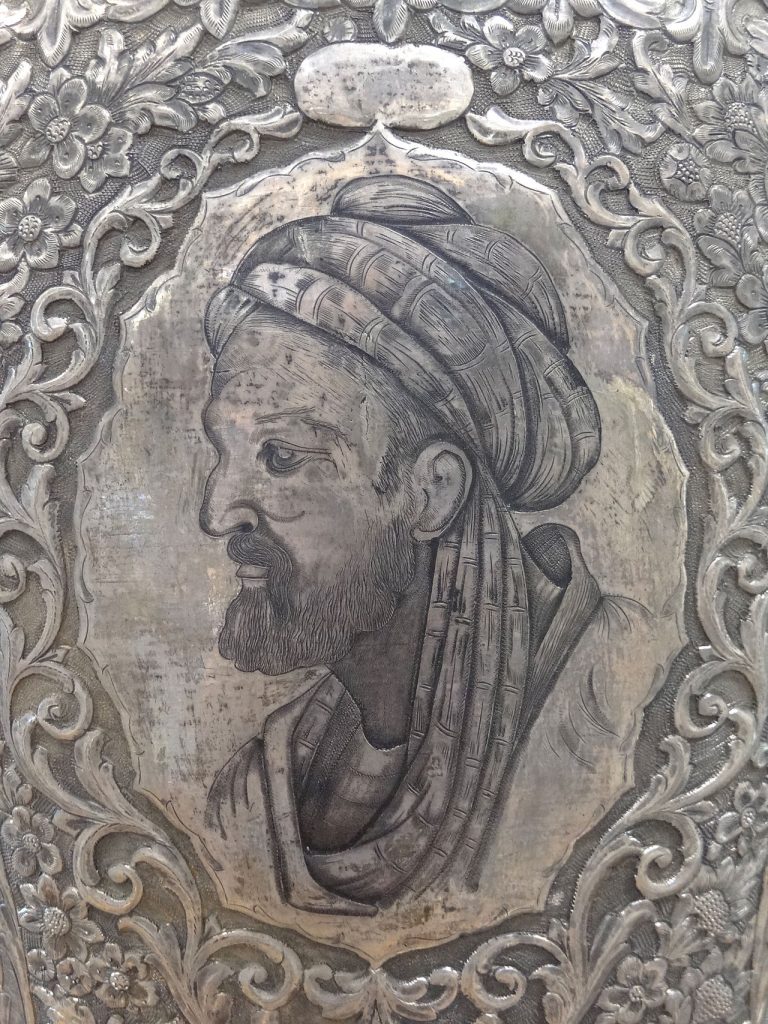
The Prince of Physicians
by Chalid Ottway.
In the region of Ibn Mansur, Amir of Bokhara, Arabia, in the year 980 A.D., in the town of Afshena, the first son of the Collector of Taxes was born. This boy, Abu, Ali Al-Husain lbn Abdallah lbn Sena, whom we shall call by his better known name, Avicenna, was destined to a career of undreamed of brilliance. He was to give to mankind new and superior methods for the prevention and treatment of disease that were to revolutionize the standard practices of his time, and to leave behind him the illustrious title. Prince of Physicians.
When Avicenna’s younger brother was born, his parents moved to Bokhara, which was then the chief city of the Moslem world, famous, even before its conquest by the Saracens, for its culture. Here, Avicenna was placed under a noted tutor, and soon proved himself a most precocious student. At the age of ten, he had not only mastered the Koran, but the Arabian Classics as well, and his tutor made no secret of the fact that the position of pupil and teacher was now reversed.
With an ambition that brooked no denial Avicenna continued to study medicine, astrology and kindred subjects, under the tutelage of the wandering scholars who, at that time, made their living by attending the sick and imparting their knowledge to the younger men. It was not long before Avicenna discovered that in most cases, his so-called teachers were nothing more than charlatans, or that his own learning was far in advance of theirs.
Aided only by the written works of others, he continued to study the higher branches of the Arts, and assiduously put into practice his medical knowledge. History records that he read “Metaphysics by Aristotle” forty times in an endeavour to fully understand this ponderous work, but in spite of this continual reading, its meaning remained hopelessly obscure, until for a few cents, he purchased a commentary written by Farribi. With this simple little aid, he obtained a complete mastery of the subject matter contained in Aristotle’s works.
At the age of sixteen, he had mastered medical theory and according to his own accounts, perfected his methods of treatment and preparation of remedies by continual attendance upon the sick without charge.
At the age of seventeen, he was appointed Chief Physician to the Amir, after having cured him of a dangerous illness that had baffled the noted doctors of the time, and was further rewarded by being given access at all times to the wonderful collection of books in the Royal Library.
A few years later, the Library was totally destroyed by fire. Avicenna’s enemies accused him of arson, saying that it was his intention to conceal for all time the sources of his marvelous powers and learning. This contention, however, was never proved.
All through the period in which Avicenna lived, his country was riven by feuds and war. In the year 1004 the Saminid Dynasty came to an end. Declining the offer of the position as physician to Mahmud the Ghasnivia, he began his wanderings from town to town in Khiva and Khorasan seeking an outlet or market for his talents.
During the siege of Darlem, in 1012, Avicenna suffered so from privation, that he was taken seriously ill. When he recovered, he sought the assistance of a friend and settled in Joryan, near the Caspian Sea. There, he lectured on logic, astronomy and medicine, and wrote several treatises, in addition to commencing his famous “Canon of Medicine”.
The constant feuds of those in power, forced Avicenna to travel west, and he stopped at Rai, in the vicinity of modern Teheran. Eventually he settled in Hamadan, where he continued his prolific writing, completing thirty more of his works, and his Canon of Medicine, comprising in itself five volumes, which were dictated and explained to his pupils day by day.
He was consulted by the Amir who afterwards appointed him to the office of Vizier. This appointment caused much jealousy, and roused Avicenna’s enemies to plot against his life. An order for his execution was signed by Shamus Addaula, and Avicenna was forced to hide in the cellar of a Sheik’s house for forty days, at which time a pardon was obtained by royal command in order that he might attend the Amir who was very ill.
War, prison and privation, coupled with the intense mental strain of overwork, punctuated by strenuous bouts of material pleasures, undermined Avicenna’s constitution and depleted his stamina.
During one of the ever recurrent campaigns, he was seized on the battlefield with a serious stomach trouble. He applied to himself remedies that were so strong that he had to return to the city. A similar seizure at a later date warned him that the disease was gaining ground. He resigned himself to his fate, realizing that his weakened system could not stand the arduous regimen necessary to check the disease.
With characteristic thoroughness he bestowed all his goods upon the poor, and freed his slaves. The latter part of his days was spent in listening to the reading of the Koran, from which he derived much comfort, and thus in the month of June, 1037, Avicenna passed from this world. But the works of this Prince of Physicians lived on, and became the guides to the medical study in the European Universities from the twelfth to the seventeenth century, and are again, in the writings that will come*, carrying on their task of enlightenment and mercy.
A Note on Pronunciation
It is felt that it is wise to give here a literal translation of Avicenna ‘s name, since the one with which we are familiar is in reality the English corruption of his Arabic nickname. It is well to keep in mind too, that each Arabic word has several meanings, so that a word may appear in its translated form at one time in one manner, and at another in different manner.
Abu Ali Al-Husain lbn Abdallah lbn Sena
Abu – Title of respect such as our Sir.
Ali – His father’s given name.
Al – Roughly translated, in this case means, of.
Husain – The Persian calling of the family name, which is in Arabic, Nesaif.
Ibn – In this case, means son.
Abdallah – Avicenna’s given name.
Ibn Sena – Son of Abyssinia, or coming from Abyssinia.
It was by this name that our Doctor and Philosopher was known, that he might be distinguished from others of the same family name, and it is from this nickname, Ibn Sena that the English corruption, Avicenna comes.
So, literally, we have Mr. Ali Al Husain’s son, Abdallah, who comes from Abyssinia.
*Note: I intend to feature extracts from Chalid Ottway’s writings in future blogs, including some of his wonderful formulas!
Conversations with Nick and Penny: Why "Everything Herbal" and Why Now?
Question: Why "Everything Herbal" And Why Now?
A Conversation with Nick and Penny
Our Primary Objective
Our primary objective is to give back to the herbal community for all that it has given to us. We aim to support and help uplift herbalists in Canada and abroad, and promote the vital work that plant people have tirelessly dedicated their lives to.
It is really important to us that we help and support herbal enthusiasts and practitioners of herbal medicine and their patients. We want to help students and those with a general interest in plant medicine to find premium quality, sustainably and ethically produced medicines and supplies. Those who are looking to learn about herbal medicine need to be able to find accurate and reliable educational resources. How best to grow herbs. How to source plants and seeds. How to spread awareness of endangered plants and help restore and bring vitality back to our increasingly threatened ecosystems.
A Reliable Source for Information
Sadly, there are too many places online where disinformation runs riot, and this only serves to demean the work of the herbal community at large. We are here to uplift and support our community, not just to be critical and point fingers. Now is the time for us to join together and help spread the news of herbal medicine to everyone. Herbal medicine is, and always will be, the medicine by and for the people.
The Everything Herbal team has decades of combined experience in all aspects of herbal medicine, from the field to the consulting room. Some of the members of our team are getting older, and would like to pass on the experience that they have acquired. Herbal medicine has always been a generational practice. Both teachers and students benefit when knowledge is transmitted in this way. In a field so vast and complex, it is easy to make mistakes, but when the younger generation works with its elders the integrity of the work that is carried out can be maintained at a higher level. Learn from those that came before you and avoid repeating their mistakes. Then create something even better!
Having spent a lifetime working in the herbal medicine world and dealing with the forces of industry, we have seen more than our fair share of deceit, manipulation, lies and untruths. It is unethical and cruel to sell products based on lies, hype, and inflated marketing claims. Rather, we believe in working from a rooted foundation, with solid science, detailed study and rigorous experience backing what it is that we do. With the over regulation of herbal products in Canada and the EU, for example, much of the skill, science and art of herbalism has been taken away from many herbalists and ensconced in the bureaucratic establishment, doled out and monetized, to those willing to play the game.
Back to Herbal roots
Yes, we want Everything Herbal to be subversive - but in a positive way. Just because you are told not to do things by those who don’t know any better, does not mean you cannot or should not. Many important herbs have been restricted by the medical establishment, and become out of the reach of real herbal practitioners. Much herbal tradition has been forgotten, including a great deal of insight from the folkloric, mystical and magical traditions of the past, which have been victimized and denigrated through prejudice and fear.
We care deeply about bringing herbal medicine back into everyday use. In the industrialized world, much of the common household knowledge that was held by our ancestors and used to help maintain the health of the community, has been forgotten, and even disparaged. Reviving this forgotten knowledge will help sustain our society, and play a major role in creating a healthier, happier and more equitable and compassionate world.
It is not our intention to cast ourselves as the authority on anything. Quite the contrary. Our aim is to bring us all together and to help create a brighter future under the banner of humility, mutual cooperation and respect. When we work together as a community our shared knowledge and experience will be taken more seriously and will be shown the respect that it deserves. Genuineness and truthfulness are at the core of this endeavor.
Many of us in the herbal community have been isolated from each other for far too long. We are looking forward to creating a brighter, greener future, together.
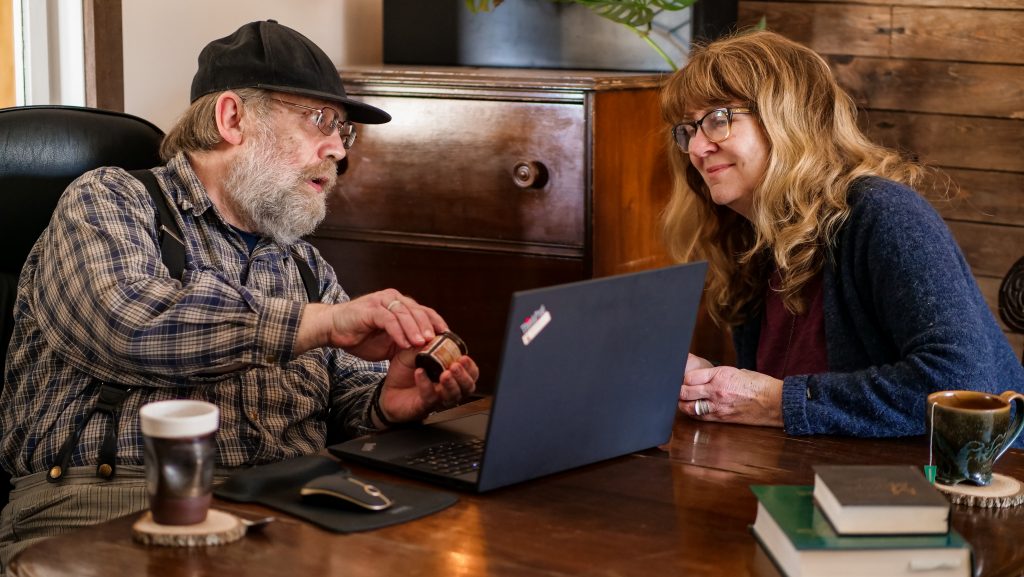
If you have any questions or topics you would like us to talk about and discuss, please send us a message or email!
Plants and Humankind
Plants and Us
Most of us show an appreciation, if not love, for the plants that surround us. But culturally, even if we recognize the nutritional, medicinal, and aesthetic benefits that plants offer to us, the complexity and deep rooted significance of our relationship with the plant world has been clouded over by the fast pace of technology and the demands of modern life. We are now at a time, however, when many are hearing the call of the green world anew, and for good reason.
Plants have always played an integral role in human culture. Besides providing us with food, plants have always served as our primary source of medicine. We can see that this is true even today in the context of modern pharmaceuticals: consider that of the most 150 commonly prescribed pharmaceutical drugs currently in use 74% derive from plants, 18% from fungi, 5% from bacteria, and 3% from vertebrae species, e.g. snakes and frogs. Plants have also served as a primary and essential source of inspiration behind the world’s great artistic, spiritual and religious practices and traditions.
It is without question that plants are essential to the foundation of life on planet Earth. When it comes to us humans, we simply could not have evolved physically, mentally, or culturally without the great services that plants provide to us. However, when we look at the relationship between human beings and plants closely, we see that it is one characterized by a process of co-evolution and cooperation that has gone on for millions of years. Animals, including human beings, have been shaped by plant life and have shaped it in turn. This process is one of reciprocity, and not one that is dictated and controlled by any of the players in the great web of life.
Modern plant biology has revealed to us that plants possess intelligence, engage in purposeful behaviours, transmit information, and even have a form of memory. When it comes to understanding the fundamentals of our shared life on Earth, it helps if we recognize that plants are not so different from animals after all. As plant scientist Anthony Trewavas has observed: “plants have the same biological criteria for survival as animals – the need to obtain food, to see off competitors, deal with pests and disease, and access mates.”(*1)
We are now in a time characterized by major global ecological challenges, and in order to face them responsibly and with integrity we must regain an understanding of our interdependence with the plant world. Much of the ecological hardship that we are seeing on Earth today has to do with neglecting our relationship to the plants, forgetting and losing sight of the intimacy that human beings have always shared with them. Valuing and protecting plant biodiversity will provide the resources with which we can forge a sustainable future. The plant world is the repository of vital information that will help us to deal with global challenges, from the growing threat of anti-biotic resistant bacteria to the dramatic environmental and climactic changes that are currently underway.
At Everything Herbal one of our primary commitments is to plants as medicine. From the perspective of traditional plant based healing traditions, a healthy organism is one that is in balance with itself and with the dynamic, vital forces that give it and define its life. Plant medicine is holistic medicine, and a holistic state of health means that all of the parts of an organism are working together to sustain a harmonious whole. Holistic health further means that the organism is in balance with the world that surrounds it and of which it is a part. Plant medicine has a great deal to teach us about ourselves, each other, and about the world in which we collectively exist. This has always been true, but it is perhaps especially true now, in these truly unprecedented times. Now is the time to learn to tap into the deep evolutionary memory of our embeddedness in the green world. This memory holds the keys to unlock the understanding of who we are as individuals and as a species, and can show us a great deal about what our place in the world can and should be. May the love that we share for the plants grow and prosper.
*1 Anthony Trewavas. Plant Behaviour and Intelligence. Oxford: Oxford University Press, 2014. Pg. 11.

